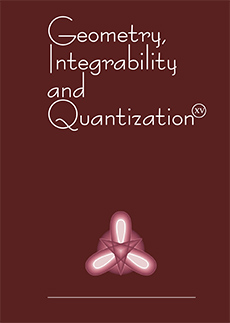Abstract
The multi-component nonlinear Schrödinger equations related to $\mathbf{C.I} \simeq \mathrm{Sp}(2p)/\mathrm{U}(p)$ and $\mathbf{D.III}\simeq \mathrm{Sp}(2p)/\mathrm{U}(p)$-type symmetric spaces with non-vanishing boundary conditions are solvable by the inverse scattering method (ISM). We focus our attention on the single threshold case. We formulate the spectral properties of the Lax operator $L$, which is the generalized Zakharov-Shabat operator. Next we construct the corresponding fundamental analytic solutions (FAS) and adapt the Wronskian relations for the constant boundary conditions. They allow one to analyze the mapping from the class of allowed potentials $\mathcal{M}$ to each of the minimal sets of scattering data $\mathcal{T}_{i} = 1,2$. The ISM for the Lax operator $L$ is interpreted as a nonlinear analog of the Fourier-transform method. As appropriate generalizations of the usual exponential functions we use the so-called ‘squared solutions’, which are constructed in terms of the $\mathrm{FAS}\, \mathcal{x}^{\pm} (x,\lambda)$ of $L$ and the Cartan-Weyl basis of the Lie algebra, relevant to the symmetric space. Finally we derive the completeness relation for the “squared solution” which turns out to provide the map from $\mathcal{M}$ to each $\mathcal{T}_i = 1,2$. Such decompositions allow one to derive all fundamental properties of the multi-component nonlinear Schrödinger equations.
Information
Digital Object Identifier: 10.7546/giq-11-2010-42-67


